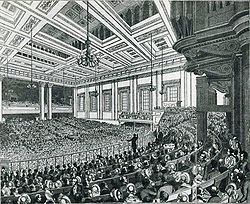Classical liberalism
Classical liberalism is a type of liberalism. It is a belief in economics and a political ideology. It is about civil and economic freedom.[1][2]
Classical liberals believe in a small government, and believe that people will be ruled mostly by natural law. They believe that people have inalienable rights, which is to say rights that cannot be taken away. They also believe in a free market and property rights.
Notable people who developed classical liberalism during the 18th and 19th century are Adam Smith, Thomas Malthus and Thomas Jefferson. More recently, in the mid-20th century, Ludwig von Mises, Friedrich Hayek and Milton Friedman were in favor. Many of the beliefs of classical liberalism are similar to those of libertarianism, in addition to some forms of conservatism.
Classical Liberalism Media
A meeting of the Anti-Corn Law League in Exeter Hall in 1846
References
- ↑ Hudelson, Richard 1999. Modern political philosophy , pp. 37–38
- ↑ Dickerson M.O. et al 2009. An introduction to government and politics: a conceptual approach, p. 129.
+{{{1}}}−{{{2}}}
